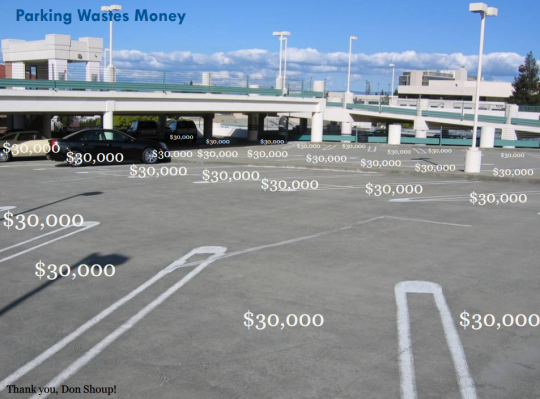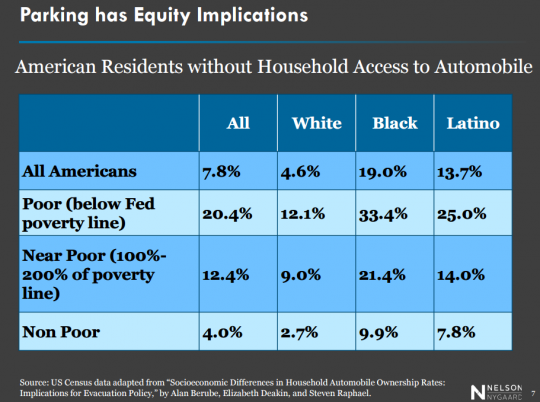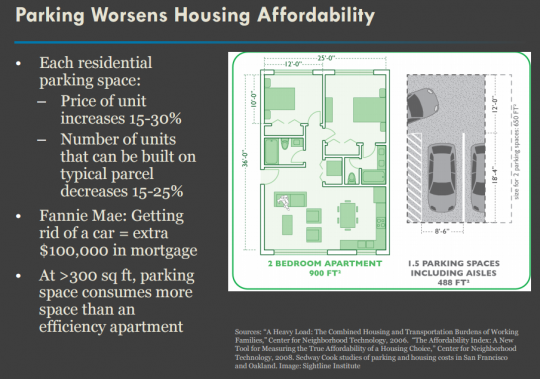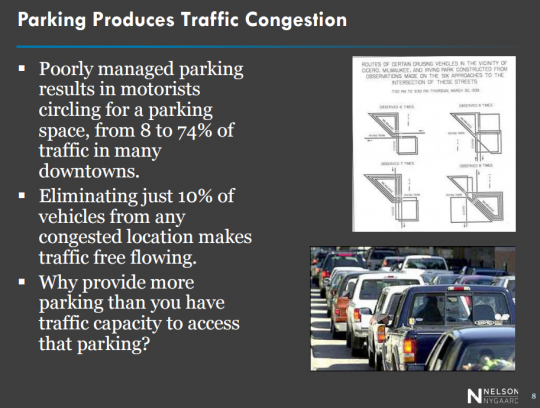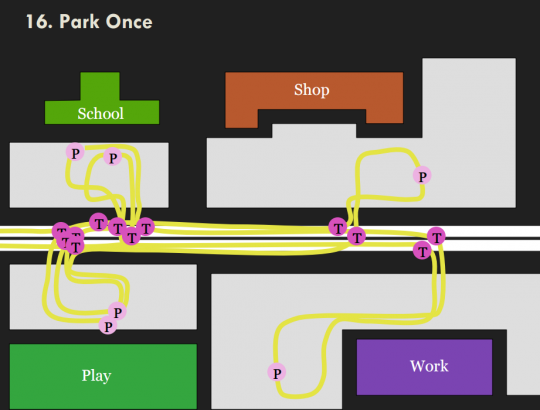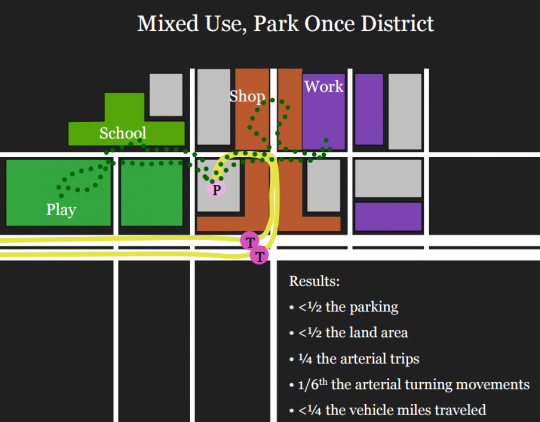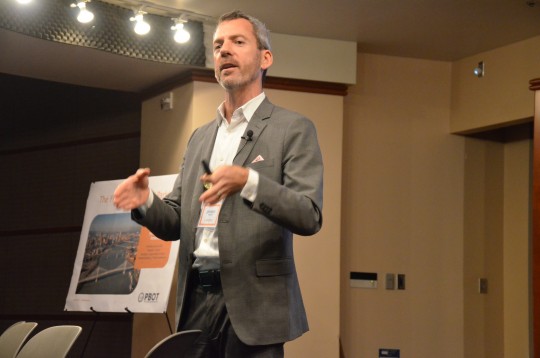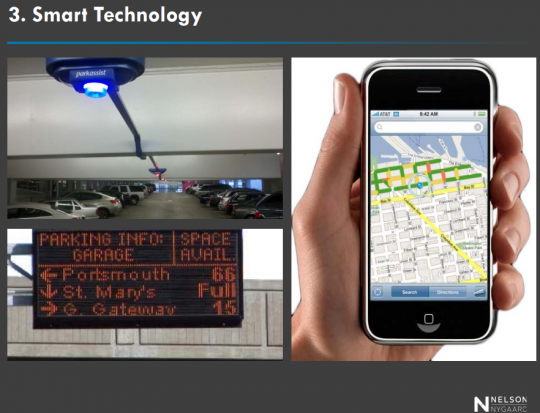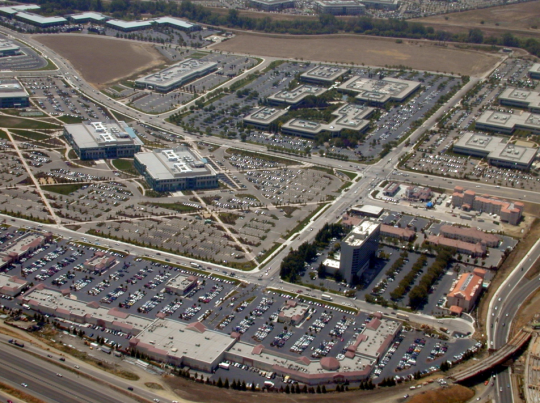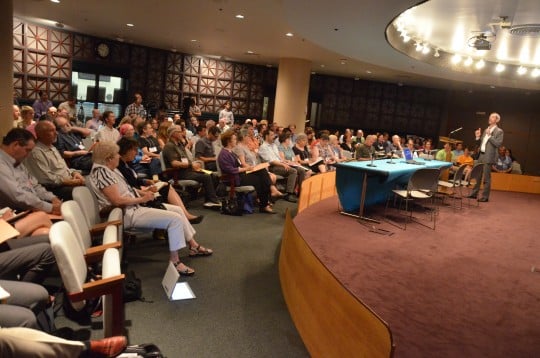
(Photos: M.Andersen/BikePortland)
“Our cities have minimum bedroom requirements for cars but not minimum housing requirements for people.”
— Jeffrey Tumlin
If anyone needed evidence that parking policy matters to Portlanders, it arrived at the Portland Building Monday in the form of 130 people, many armed with pen and paper, to attend a five-hour “symposium” on the subject.
The event organized by the Portland Bureau of Transportation drew a who’s-who of neighborhood association and city transportation officials. One was Transportation Commissioner Steve Novick, who said that parking was the transportation issue he hears about more than any other.
The keynote speaker, Nelson\Nygaard parking consultant Jeffrey Tumlin, presented a 16-point parking strategy that revolved around a single concept: parking is too expensive and too valuable for us to conceal its costs inside the price of everything else we buy.
The key, Tumlin said, is to recognize that the cost of building and maintaining every parking space at the mall is already a burden on the public: it’s built into the price of every shirt that’s on sale inside.
“It’s not that the parking is actually free, it’s that instead of having the motorist pay for it, we’re having everybody pay for it,” he said. “You may only have 15 percent of the population without a car, but those 15 percent are subsidizing the parking for everyone else.”
The same is true in the housing market, Tumlin said. In his hometown of San Francisco, he said, each on-site residential parking space in a new apartment building drives up the cost of the room by 15 to 30 percent and decreases the space for actual human housing by 15 to 25 percent.
“Our cities have minimum bedroom requirements for cars but not minimum housing requirements for people,” he marveled.
Tumlin said that because wealthier people are so much likelier to own cars, San Francisco has found that zero-parking apartments are less susceptible to rent spikes.
“Yuppies will invade every neighborhood as long as there is a place to park their SUVs,” he said.
Another problem of free parking: traffic congestion. Tumlin said 15 percent or more of traffic on commercial streets is “not traffic that’s going anywhere, it’s just people circling around looking for a place to park.”
This is especially costly, Tumlin said, because parking requires so many turns, which clog roads especially fast. This graphic shows a hypothetical person’s trips around a neighborhood that manages its parking by providing enough space for everyone to park for free. The P markings are parking spots and the T markings are turns:
Tumlin contrasted this with “park-once” neighborhoods, which he said make it possible to park but keep everything close enough that people walk in between their destinations:
These problems with parking have some interesting implications, Tumlin said.
“Too much parking can be even worse than too little,” Tumlin told the crowd. “Instead of talking about how many new parking spaces we need, we should talk about how we can manage those new spaces and, even more importantly, how to manage the resources we already have.”
Advertisement
The road to good management, he suggested, starts with charging for parking in high-demand neighborhoods.
“The correct price of parking is the lowest price where there is almost always one or two parking spaces available in a given parking lot or block,” he said. “This is also the correct way to set the price of every other product. This is how Southwest Airlines sells plane tickets.”
Cities often feel pressure to build more off-street parking lots, he said. But he warned that this is futile without also either pricing or regulating on-street parking.
“Creating more unused off-street parking spaces will not free up on-street spaces,” he said. “Only managing your on-street parking will do that.”
Also, he said, because parking garages cost about $30,000 per space to build, “it will always be cheaper to use technology to help motorists locate the spaces that are currently available.”
Another interesting note in Tumlin’s argument: residential programs that offer free or low-cost parking passes only to residents of the neighborhood may be unfair, but he said they’re a tradeoff worth making in order to institute paid parking in fast-changing commercial areas nearby.
“Warning: residential parking permits are anti-market and anti-democratic,” he said.
What does this all mean for people who care about biking? Though bike lane believers are accustomed to battles over removing parking, Tumlin’s prescription for good parking policy really isn’t about making it easier to take parking spaces off the street. Instead, it’s mostly about changing something even more fundamental to a city than its streets: its buildings.
A city where parking is plentiful, Tumlin said, is familiar, because most neighborhoods built after 1950 (when U.S. cities started requiring off-street parking) look so similar:
This isn’t, needless to say, the sort of neighborhood where many people will choose to ride a bicycle or (even worse) walk or use public transit. The point of parking reform isn’t to improve biking tomorrow; it’s to prevent a city from gradually transforming into the picture above.
“Your regulations are about the city you want 40 years from now,” Tumlin said.
— Learn more about PBOT’s work at their Central City Parking Strategy webpage.

